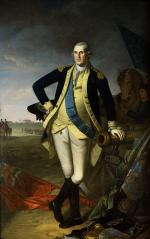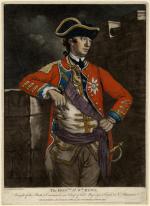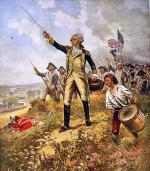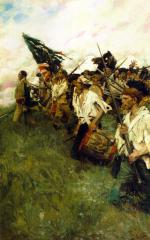Chapter Two: The Battle of Brandywine
“Should [the British] push their design against Philadelphia, on this route, their all is at stake; they will put the contest on the event of a single battle: If they are overthrown, they are utterly undone, the war is at an end. Now then is the time for our most strenuous exertions. One bold stroke will free the land from rapine, devastations and burnings, and female innocence  from brutal lust and violence.”
from brutal lust and violence.”
-General George Washington, September 5, 1777
Neither General George Washington nor
On July 23, 1777, General Howe departed from northern New Jersey with 18,000 men on board 260 ships. Originally, he planned to sail up the Delaware River and attack Philadelphia by sea. Fearing
Since its founding in 1682, Chester County had been home to thousands of conservative Quakers who practiced strict pacifist beliefs. Although they welcomed neither army onto their soil, local Quakers in September 1777 found themselves in the middle of a civil war. Besides refusing to fight, the Quakers were very reluctant to share vital information with either of the two armies. Both General Howe and more so General Washington had great difficulty in gathering reliable intelligence once they arrived in Pennsylvania.
Upon arriving in Birmingham Township on September 9, 1777 Washington immediately began to fortify the area. Realizing the British needed to cross the Brandywine, he concentrated part of his 12,000-man army around the largest crossing point on the river;
Since leaving northern New Jersey in July, the British had struggled against thunderstorms, strong winds, and extreme heat. “If I could own the whole of America,” a German Hessian wrote, “I would refuse if I had to live in these hot regions.” Arriving in Kennett Square, the British caught their first break when local Loyalists informed them of the two undefended fords. The morning of September 11th greeted both armies with uncomfortably high temperatures. Hoping to catch Washington off guard, General Howe, despite the extreme heat, ordered General Charles Cornwallis to lead a seventeen-mile forced march from Kennett Square to outflank the Continental Army. At 4am Cornwallis led 8,000 men north towards Trimble’s Ford. [
Howe was confident that he could defeat the Continental army by a rapid flanking movement. In July 1776, he had successfully used a similar strategy at the Battle of Long Island that had forced General Washington to evacuate New York City. Howe hoped that the wooded areas of the Brandywine Valley would make it difficult for Washington to recognize where his 8,000-man force was moving.
As Howe and Cornwallis led the main body of the British army towards Trimbles and Jeffries Fords, Knyphausen’s troops advanced against Continental Army General William Maxwell’s light infantry division to the west, reached the river by 11am, and stopped their advance. They remained there for the next five hours because Knyphausen had been ordered to wait for confirmation that Cornwallis and Howe reached their destination, before he crossed the Brandywine and renewed his advance.
During this mid-day lull, Washington confidently believed that he halted the entire British Army at Chad’s Ford, despite conflicting reports of British movements near Trimble’s Ford. Conflicting reports about the exact position of the British Army would continue to confuse Washington all afternoon. It was not until Colonel Theodorick Bland at 1pm spotted the British to the north that Washington knew his army was in danger.
Washington responded by sending three divisions under generals Alexander Stirling, Adam Stephen, and John
At 2:30pm, Cornwallis and Howe stopped near
At 4pm, Howe launched the main
When Greene’s division halted the British advance at 7pm, near
That night Washington and his Continental Army retreated southeast to Chester, Pennsylvania, some fourteen miles from the field of battle, where they regrouped and assessed the damage. Stories of patriotic and heroic actions during the day’s fighting echoed throughout camp. Many of the young soldiers had exhibited immense bravery, including twenty-year-old
For the next few days the British remained in the area, assessing the damage, and taking care of the wounded. On September 16th, Howe began the final advance towards Philadelphia, and entered Philadelphia on September 26th. The British would remain there for the next nine months.
When all of the numbers are tallied, the Battle of Brandywine ranks as the the third bloodiest battle of the Revolution. According to some historians the battle in the Brandywine Valley and the













